| Article ID | Journal | Published Year | Pages | File Type |
|---|---|---|---|---|
| 5760700 | Biological Control | 2017 | 28 Pages |
Abstract
Saddle gall midge (Haplodiplosis marginata) is a cereal pest exhibiting sporadic outbreaks for which chemical control options are limited. Integrated Pest Management programs may offer a means of suppressing H. marginata outbreaks, reducing pesticide input. Many IPM programs benefit from the natural population suppression inflicted through predation and parasitism. The larval stage of H. marginata overwinters in the soil and may be preyed upon by ground-dwelling arthropods, however the natural enemies of H. marginata remain unrecognized. A PCR-based assay for detecting H. marginata in the guts of predators was designed using novel species-specific primers. Feeding trials involving H. marginata larvae showed a detectability half-life of 31.07â¯h post-feeding in Nebria brevicollis. The guts of field-caught Carabidae were screened for H. marginata DNA. Four species: Poecilus versicolor, Nebria brevicollis, Harpalus rufipes and Loricera pilicornis were identified as natural enemies of H. marginata for the first time. A higher proportion of positive results were obtained at the end of H. marginata emergence (July) compared to the beginning (May). The importance of understanding trophic interactions in the management of H. marginata is discussed in addition to the potential uses for the newly designed assay and primers.
Related Topics
Life Sciences
Agricultural and Biological Sciences
Agronomy and Crop Science
Authors
Charlotte Rowley, Andrew J. Cherrill, Simon R. Leather, Alexander W. McCormack, Janetta E. Skarp, Tom W. Pope,
